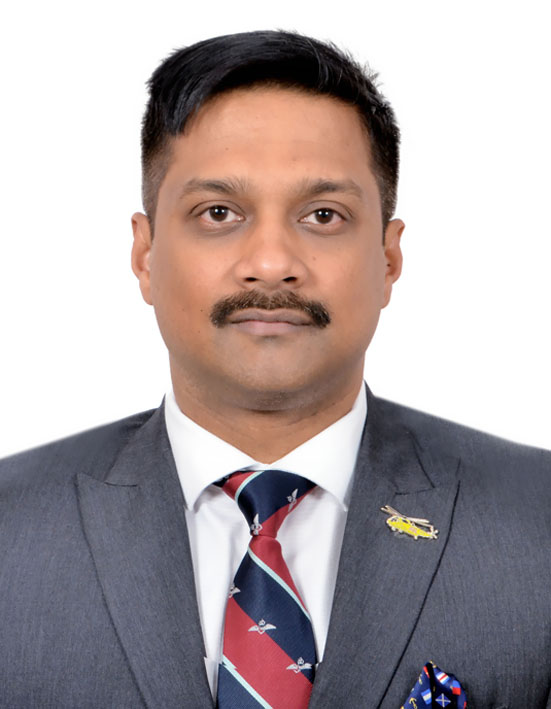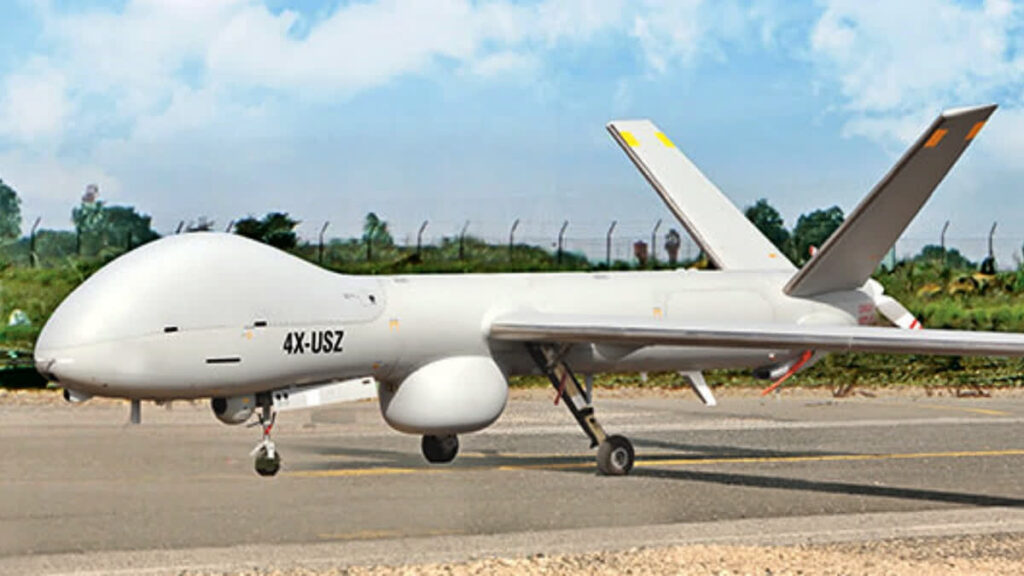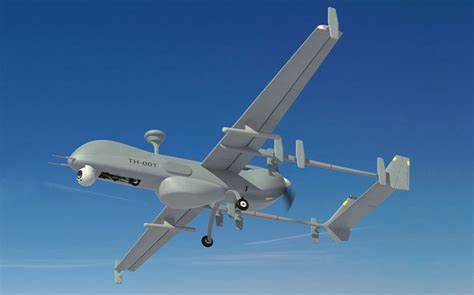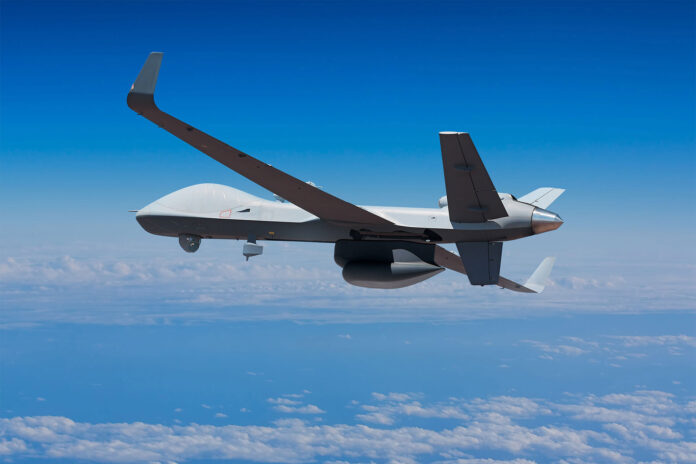Cdr Rahul Verma (r)

India’s military UAV doctrine is at a turning point. With the confirmed procurement of 31 MQ-9B SeaGuardian drones from General Atomics under a landmark $3.9 billion deal, New Delhi is signalling more than a mere capability upgrade, it’s suggesting a shift in strategic thinking. As the Indian Armed Forces induct more High-Altitude Long-Endurance (HALE) RPAS, the traditional role of Medium-Altitude Long-Endurance (MALE) UAVs appears increasingly redundant.
The question facing India’s military planners today, I presume, is, Does India need to continue investing in MALE UAVs, or can HALE platforms sufficiently cover the operational spectrum at a better return on investment (ROI)?
HALE vs. MALE: Mission Capability and Operational Edge
HALE platforms like the MQ-9B operate at altitudes beyond 40,000 feet and can stay airborne for over 40 hours, doubling or tripling the endurance of most MALE drones like the Dristi-10 or indigenous TAPAS-BH. This endurance gap is even larger when comparing Time on Task with all sensors loaded. Their higher altitude also translates into wider sensor coverage, making a single HALE drone capable of surveilling vast geographic areas, including sensitive zones like the Line of Actual Control (LAC), the Arabian Sea, or the Andaman Sea chokepoints.
Sensor Superiority. MQ-9Bs carry multi-mode maritime radars, EO/IR sensors, SIGINT payloads, and Synthetic Aperture Radar (SAR), with the ability to fuse and stream data in real time to multiple nodes. This allows them to serve both strategic and tactical intelligence roles, a flexibility that MALE UAVs struggle to match.
Interoperability. HALE UAVs offer greater plug-and-play compatibility with India’s tri-service network-centric warfare systems. They can seamlessly link with P-8I aircraft, satellite constellations, and airborne early warning platforms—critical for maritime domain awareness, long-range ISR, and potential precision-strike missions.
The Economics: Cost vs Capability vs Coverage
1. Cost Per Flight Hour (CPFH) and Lifecycle Cost Analysis. While the MQ-9B appears expensive at ~$100–120 million per unit (including associated systems, values are just an estimate), this should be weighed against its multi-mission flexibility and coverage. In contrast, MALE UAVs may cost around $30–40 million per unit (values are just an estimate), but require multiple airframes, crews, and logistical support to match the capability and persistence of a single HALE platform. The cost per square kilometer of persistent surveillance and the lifecycle cost per mission objective favours HALE systems when scaled effectively, as estimated.
- MQ-9B: $3,600–4,000 CPFH (average)
- Heron / Hermes / TAPAS-BH: $2,000–2,500 CPFH
But this basic comparison is misleading unless contextualized.

A single MQ-9B can replace up to 3–4 MALE UAVs in coverage area, persistence, and operational reliability. This reduces manpower, maintenance, and logistic footprints while simplifying mission planning. Over a 20-year service life, the cumulative savings from reduced operational complexity and mission redundancy more than offset the higher upfront cost.
A significant contributor to the MQ-9B’s performance and efficiency is its turboprop engine configuration, which provides a superior thrust-to-fuel consumption ratio compared to piston-powered MALE UAVs. This enables better fuel efficiency and supports a higher glide ratio, allowing extended loiter time and improved endurance even in challenging environments. Crucially, the MQ-9B is designed for all-weather operations, equipped with anti-icing systems, weather radar, and hardened avionics that allow it to operate in heavy rain, turbulent wind conditions, and low-visibility environments, operational domains that typically ground or limit MALE UAVs.
In addition, the platform is built with triple-redundant flight control systems, dual-redundant SATCOM links, and failsafe protocols, delivering significantly higher mission reliability and resilience. This enhanced survivability allows the MQ-9B to maintain ISR and surveillance continuity even during monsoon conditions or in regions affected by sudden weather shifts critical for Indian theatres such as the Himalayas and the Indian Ocean Region. With fewer aborted sorties and reduced downtime due to weather limitations, the MQ-9B ensures greater mission assurance per airframe, further justifying its replacement value for 3–4 MALE UAVs. Over a 20-year service life, the cumulative savings from reduced mission attrition, manpower, maintenance cycles, and logistical complexity more than offset the platform’s higher upfront cost, making it a superior economic and operational choice for persistent surveillance and strategic missions.
2. Economies of Scale and Unified Training. Operating a mixed fleet of diverse MALE UAVs, many of them foreign-built (Hermes 900 Starliner/ Drishti 10 from Adani-Elbit, Heron from IAI, and Searcher from IAI.) and some indigenous (TAPAS-BH) creates logistical fragmentation, duplication in training pipelines, multiple support ecosystems, and complex supply chains.
By consolidating around a robust HALE platform like the MQ-9B, India benefits from:
- Unified operator training programs across the three services
- Streamlined maintenance regimes
- Lower spares inventory diversity
- Easier upgrades and lifecycle modernization
When scaled across the Indian Navy, Army, and Air Force, these benefits contribute to significant lifecycle savings and increased mission readiness.
3. ROI in Strategic Deterrence and Diplomatic Value. MQ-9Bs aren’t just surveillance drones, they are strategic assets. Their acquisition plays into larger geopolitical equations:
- Interoperability with QUAD partners (especially the US, Japan and Australia)
- Force multiplier in the Indo-Pacific under India’s SAGAR (Security and Growth for All in the Region) vision
- Bilateral data-sharing opportunities with the US Indo-Pacific Command
This gives India not just operational utility, but strategic leverage, a form of ROI not easily quantifiable in rupees but invaluable in diplomatic and deterrent terms.
Survivability and Tactical Flexibility in Contested Airspace
As India recalibrates its drone doctrine for modern conflict scenarios, understanding the operational trade-offs between HALE and MALE platforms becomes essential. The edge lies not just in altitude but in endurance, adaptability, and mission relevance. MALE UAVs, operating typically at altitudes between 10,000 to 30,000 feet, are significantly more vulnerable to a wide range of enemy Surface-to-Air Missile (SAM) systems from man-portable air defences (MANPADS) to medium-range radar-guided interceptors. Their slower climb rate, piston-engine propulsion, and limited thrust-to-weight ratio prevent rapid repositioning or vertical escape from threat envelopes. This is particularly problematic in joint-theatre operations where rapid ISR responsiveness and survivability across domains, air, land, and sea are critical. HALE platforms like the MQ-9B, cruising above 40,000 feet, remain well above most tactical SAM coverage and can employ gambit tactics: entering contested zones at standoff distances to provoke radar or comms emissions, allowing them to cue SIGINT payloads or coordinate real-time responses without exposing themselves to engagement.
The disparity becomes even more stark in the Himalayan terrain, where vertical relief compresses operational airspace and requires ISR platforms to operate at high altitudes with persistent loiter. MALE UAVs often cannot achieve the altitude needed to clear ridgelines or overcome severe downdrafts, let alone operate with sensor effectiveness in those thin-air conditions. In contrast, HALE UAVs, with turboprop engines, anti-icing systems, and superior power margins, can not only sustain flight over the Himalayas but also provide stable ISR platforms above rugged terrain and hostile air defence coverage. Their altitude advantage and networked interoperability make them ideally suited for real-time targeting, cueing long-range fires, and maintaining ISR overwatch across multiple domains, essential for future Theatre Command structures where air, ground, and maritime assets must operate in seamless coordination. In such theatres, MALE platforms are not only more exposed but tactically outclassed.
These limitations underscore a hard truth: in the evolving realities of high-altitude border standoffs and integrated joint-force operations, MALE UAVs are increasingly ill-suited for front-line roles both in terms of survivability and mission impact. The future of persistent, resilient, and tactically agile ISR lies firmly in the HALE domain.

Redundancy and Relevance: Are MALE UAVs Still Necessary?
Proponents of MALE UAVs argue that they are cheaper, locally produced (in the case of TAPAS-BH and other private players), and suitable for tactical ISR or internal security operations. However, three trends are reducing their relevance:
- Miniaturization of Sensors. Smaller drones and loitering munitions are now able to carry out short-range ISR and strike roles at lower costs and risks. Tactical needs can increasingly be met with expendable, lower-end platforms like swarming UAVs.
- Manned-Unmanned Teaming (MUM-T). Rotary-wing aircraft/ Micro GT powered Systems with AI-enabled sensors are taking over tactical ISR missions in contested terrain, pushing MALE UAVs further down the utility ladder.
- Satellite and Space-based ISR. India’s growing space capabilities (e.g., RISAT, EMISAT) offer persistent surveillance for high-value assets, further reducing the need for MALE-level endurance platforms.
Indigenous vs. Strategic Value: The TAPAS-BH Dilemma
While the Defence Research and Development Organisation (DRDO) has positioned the TAPAS-BH as a cornerstone of India’s indigenous MALE UAV program, the platform faces notable limitations in both performance and timeline. Originally envisioned to operate at altitudes of 30,000 feet with ISR capabilities on par with global MALE platforms, TAPAS-BH has struggled to exceed 28,000 feet during trials and lacks the payload diversity needed for complex, multi-domain operations.
Additionally, its current configuration is not combat-capable and has yet to be cleared for high-altitude surveillance missions along the northern borders. This narrows its role to a lower-tier ISR asset, one that may soon be surpassed by smaller, cheaper tactical drones and space-based systems.
However, indigenous development remains essential not for duplicating legacy capabilities, but for investing in the next generation of unmanned platforms. This is where strategic budgeting comes into play.
Redirecting Investment Toward MALE-Plus and Next-Gen Systems
If India reduces its dependence on a large fleet of MALE UAVs by scaling up HALE platforms like the MQ-9B, the budgetary savings, both capital and operational, can be redirected to fund more future-oriented indigenous programs. This includes:
- MALE-Plus Platforms. Bridging the gap between MALE and HALE, with modular combat capabilities, higher ceiling, and stealth features.
- UCAVs (Unmanned Combat Aerial Vehicles). Like the Ghatak stealth drone program, which aims to deliver autonomous strike capabilities in contested airspace. This should be a mission-based, national program, instead of MALE.
- Collaborative Combat Aircraft (CCAs). A next-gen frontier where unmanned aircraft operate alongside fighter jets, increasing force projection without risking pilot lives. India is developing collaborative combat aircraft (CCAs) through projects like the CATS Warrior (by HAL and NewSpace) and the Abhimanyu (by NewSpace). The Indian Navy is also developing its version of the CCA, called the Naval Collaborative Combat Air Vehicle (N-CCAV), with NewSpace’s Abhimanyu as its base
Such a shift would allow DRDO and private industry to focus their R&D efforts not on catching up with today’s technology, but on leapfrogging toward tomorrow’s air combat doctrine.
Bridging Near-Term Gaps. Furthermore, this approach creates a more flexible procurement structure. In the interim, any niche ISR gaps that cannot be immediately filled by HALE platforms can still be addressed through limited TAPAS-BH use or leased MALE systems, without locking the Armed Forces into long-term dependence on a lower-tier asset. This avoids long-term duplication and obsolescence.
Strategic Synergy, Not Redundancy
By embracing HALE RPAS for strategic needs and reserving indigenous funding for disruptive technologies like Loyal Wingman systems and stealth UCAVs, India ensures its drone doctrine is not only self-reliant but also future-ready. This dual-track strategy reduces operational redundancy, maximizes ROI, and establishes India as both a net importer of strategic technology and a net exporter of next-gen drone innovation over the long term.
Geopolitical Leverage: From Tactical ISR to Tech Diplomacy
The MQ-9B deal goes beyond procurement; it is a strategic signal of technological alignment in a world increasingly shaped by techno-nationalism, digital sovereignty, and great power competition. The platform is a gateway into the interoperable tech ecosystems of the U.S. and its allies, with consequences that span defence, aerospace, cyber, and space domains.
India’s position in this emerging techno-strategic architecture is further strengthened by its signing of four foundational agreements with the United States, as mentioned on Wikipedia:
- LEMOA (Logistics Exchange Memorandum of Agreement)-2016
- COMCASA (Communications Compatibility and Security Agreement)-2018
- BECA (Basic Exchange and Cooperation Agreement for Geospatial Intelligence) -2020
- ISA (Industrial Security Annex)-2019
These agreements enable secure and seamless data sharing, tactical communication, and access to encrypted systems. When coupled with a platform like the MQ-9B, they allow India to operate in full networked interoperability with Western-origin aircraft already in its inventory, such as the P-8I Poseidon, MH-60R Seahawks, C-130J Super Hercules, C-17 Globemaster III, Apaches, Chinooks, and potentially even Loyal Wingman prototypes in the near future.
The MQ-9B is equipped with advanced tactical data links, which allow for real-time sensor and targeting data exchange between Indian and allied air, sea, and ground assets. This significantly reduces the OODA loop (Observe, Orient, Decide, Act), transforming India’s ISR posture from reactive to proactive.

- A sensor feed from the MQ-9B can directly cue a P-8I or a BrahMos-equipped strike aircraft.
- A detected submarine or vessel can be tracked, verified, and acted upon in a single operational cycle without human relay delays with P8 as well as MH-60 Romeo
- MQ-9Bs can operate as airborne command nodes, orchestrating joint-force responses in contested domains, particularly across the Indian Ocean Region (IOR).
In effect, the HALE RPAS becomes a force multiplier not just through surveillance, but by actively enhancing the lethality, coordination, and tempo of India’s joint operations. This is also aligned with the much-anticipated Military Theatre Commands.
Some other sectors where this approach could help in achieving niche techs are enumerated in the succeeding paragraphs.
1. Space and Satcom Synergy. HALE drones depend on secure satellite links for operations. Operating MQ-9Bs gives India access to shared satcom protocols and gateway technologies, enabling closer collaboration with the U.S. and allied space ecosystems.
This opens doors for:
- Joint LEO/MEO satellite constellation development
- Dual-use partnerships between Indian startups and Western satcom firms
- Real-time data fusion for both military and disaster-response missions
2. Quantum and AI Integration. Future variants of HALE drones will incorporate quantum encryption and AI-assisted sensor analytics. India’s adoption of such platforms aligns with:
- The National Quantum Mission
- Private-sector AI growth
- Early-stage access to emerging quantum-secure ISR architectures
This lays the groundwork for a trusted partner status in restricted tech corridors.
3. Indo-Pacific Strategic Influence. Persistent MQ-9B surveillance over the Indian Ocean Region enhances India’s Maritime Domain Awareness (MDA) and enables contributions to collective security frameworks like QUAD, IORA, and Indo-Pacific MDA initiatives.
This reinforces India’s image as a net security provider, strengthens naval deterrence against China’s expanding footprint, and allows India to shape regional tech norms and architectures.
4. Cross-Domain Tech Diplomacy. India’s credibility as a secure and interoperable operator of HALE platforms opens avenues for:
- Co-development of advanced propulsion and stealth tech
- AI/data-sharing consortia
- Deeper integration into QUAD and AUKUS-aligned innovation ecosystems
The MQ-9B becomes a gateway to multi-domain tech diplomacy, spanning aerospace, defence, quantum, and space collaboration.
Conclusion: The Future Is Higher
India’s investment in HALE RPAS marks a shift from layered drone hierarchies to strategic surveillance dominance. By scaling MQ-9B procurement and integrating them across military and homeland security operations, India stands to gain:
- Superior ISR coverage
- Operational simplicity
- Economic efficiency at scale
- Geopolitical leverage
In this evolving paradigm, MALE UAVs may no longer represent a cost-effective or operationally essential tier in India’s drone doctrine. Instead, the focus should be on high-altitude endurance, multi-domain integration, and future-ready technologies and that path leads clearly through HALE.
Cdr Rahul Verma (r), former Cdr (TDAC) at the Indian Navy, boasts 21 years as a Naval Aviator with diverse aircraft experience. Seaking Pilot, RPAS Flying Instructor, and more, his core competencies span Product and Innovation Management, Aerospace Law, UAS, and Flight Safety. The author is an Emerging Technology and Prioritization Scout for a leading Indian Multi-National Corporation, focusing on advancing force modernization through innovative technological applications and operational concepts. Holding an MBA and Professional certificates from institutions like Olin Business School, NALSAR, Axelos and IIFT, he’s passionate about contributing to aviation, unmanned technology, and policy discussions. Through writing for various platforms, he aims to leverage his domain knowledge to propel unmanned and autonomous systems and create value for Aatmannirbhar Bharat and the Indian Aviation industry.



